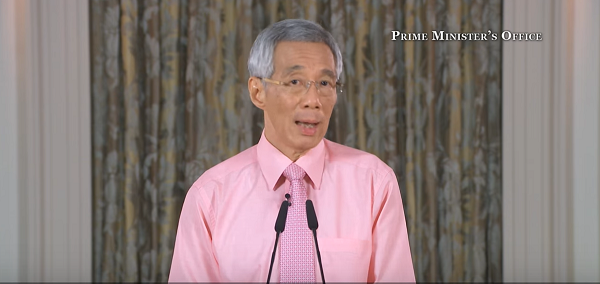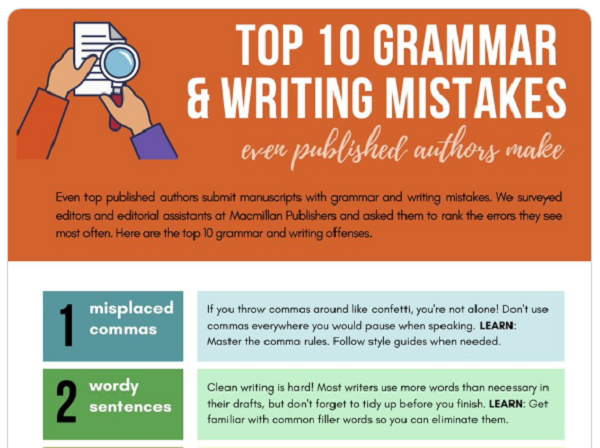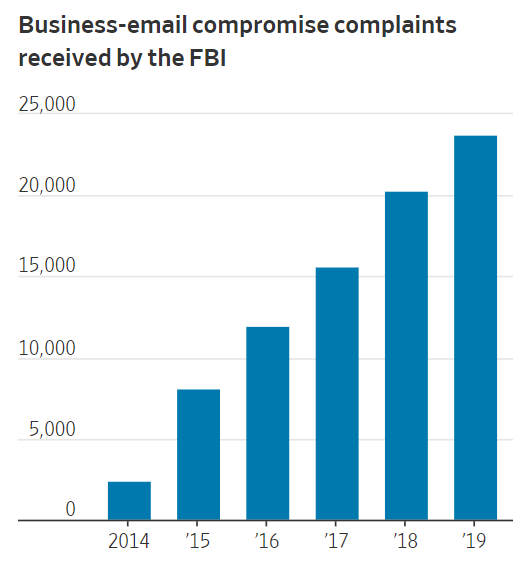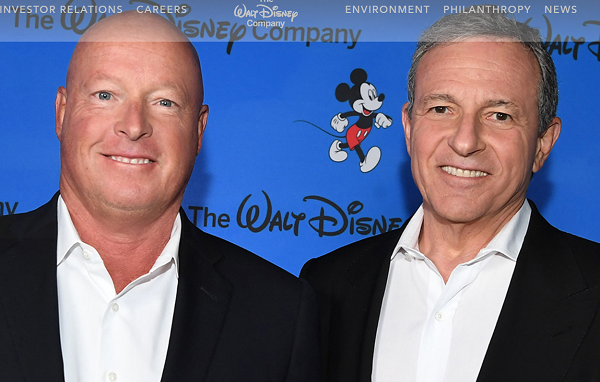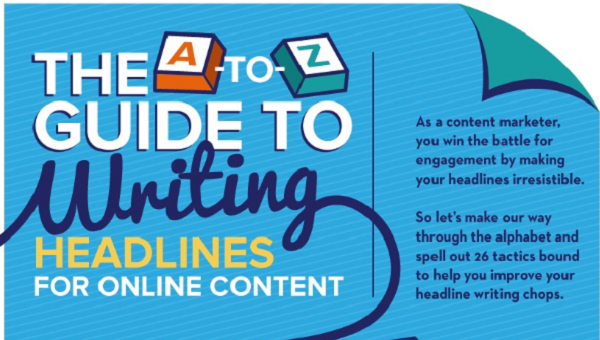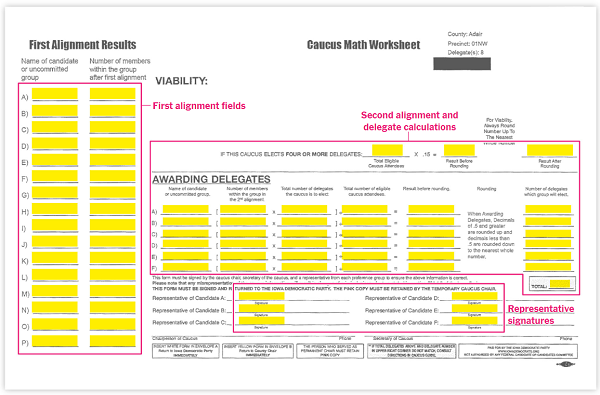Singapore PM Lee Hsien Loong
Two students sent me Singapore Prime Minister Lee Hsien Loong’s news conference as a positive example. I can see why: he gives a model speech, balancing emotional appeal and straight talk. He is proud of Singapore’s response, and yet he is honest about the challenges ahead. The PM also gives examples from other countries and the lessons learned.
Discussion:
What are the strengths of the Prime Minister’s speech?
Assess his delivery skills.
How have leaders in other countries followed this example—or how have they fell short?
Which leadership character dimensions does the PM demonstrate in his speech?
Common Writing Mistakes Infographic
An editor at Macmillan Publishing created an infographic to show the most common mistakes writers make. Misplaced commas, wordy sentences, and run-on sentences get top billing.
The list is interesting and helpful to alert writers to what they should focus on when they revise their work. I wouldn’t try to attack all of these issues on a rough draft.
Of course, some of these mistakes are more serious than others. Although they’re prioritized by frequency, other organizational strategies might be useful.
Advice at the bottom of the infographic is useful for anyone.
Discussion:
Which of these common mistakes are problems in your own writing? How have you been able to tackle them?
How else could this list be organized?
How useful do you find the advice at the bottom? What other advice would you offer writers?
Governor Cuomo's Press Conference
In his second news conference about Coronavirus, New York Governor Andrew Cuomo announced new cases, provided resources, and answered questions.
Discussion:
Assess the news conference. What does Governor Cuomo do well, and what suggestions would you have for him to improve his communication?
What strategies for answering questions does the Governor demonstrate?
Comparing Airlines Messages About COVID-19
Transportation companies would like to see more people travel, yet people are wary of COVID-19. Compare these emails to travelers:
Discussion:
Analyze the messages: audience, communication objectives, organization, writing style, etc.
In what ways are the messages similar and different? How might the travel mode—airline or bus—affect the communication choices?
Which messages are most and least effective and why?
What’s your view of the American Airlines video? How does the media choice affect the message?
CDC Guidelines to Airlines About COVID-19
The Centers for Disease Control issued recommendations to airlines and their crews to try to address COVID-19. The web page begins with the purpose:
“This document provides interim recommendations for the commercial airline industry about the Coronavirus Disease 2019 (COVID-19) first identified in Wuhan, China. CDC reminds air carriers of the requirement under Title 42 Code of Federal Regulations (CFR) section 71.21 to report to CDC ill travelers who have certain signs and symptoms during flight, and all deaths onboard, before arrival in the United States. This document also contains recommendations for managing ill travelers onboard if COVID-19 infection is suspected.”
Next is a “Situation summary,” followed by guidelines for handling ill passengers aboard a flight and for cleaning a plane after a flight.
Other sections on the CDC website address “Reporting Death or Illness” and “Managing Ill Passengers/Crew.”
Discussion:
Who are the primary and secondary audiences for CDC’s website? What are the organization’s communication objectives during the COVID-19 outbreak?
Review the CDC website from the home page. How easy is it to find information? How clear is the information you do find? In summary, how well does the organization meet its communication objectives? What could be improved?
Confusing Pie Chart
A former student sent me this chart, and he didn’t have a source, but it’s a good example of what not to do when creating pie charts. What problems can you identify?
Discussion:
What principles of creating pie charts are followed, and how does the chart fall short?
Is the pie chart the best choice for this data? What would be a better choice and why?
What does the text imply?
More Toyota Recalls
About a month after the last recall, Toyota announced another recall for a total of 1.8 million vehicles. The issue is a fuel pump that fails, causing the car to stall and possibly not restart.
In both statements, Toyota calls the recall “voluntary,” but the number of models is significant, dating back to 2013. Like most recall messages, Toyota’s is straightforward and focuses on affected vehicles and the remedy—in this case a new fuel pump for free.
Discussion:
Analyze the recall message. Who are the primary and secondary audiences, and what are the communication objectives?
Analyze Toyota’s website. How easy is it to find information about the recalls? What, if anything, could be improved?
Email Scammers
Remember those quaint email scams that were riddled with grammatical errors? A Wall Street Journal article describes new, sophisticated training for email scammers in Africa. A Nigerian is quoted: “You know how you guys play baseball when you are growing up? Here many of us learn fraud.”
Former scams involved people sending email asking for money for people in trouble or promising big returns on small funds. Today’s scams involve hacking into accounts and people learning about connections, for example, what vendors a company uses. A fake invoice to a known vendor is more likely to get paid. Using a grandson’s real name could lead a grandmother to Wal-Mart to send money to him, which happened to my friend’s mother.
About $1.7 billion was lost to email scams in 2019, and complaints are rising steadily. The article describes a “grooming” process “like organized crime.”
Discussion:
We hear a lot about victims’ vulnerability, but what creates a culture of scammers? What makes people vulnerable to commit this fraud? For more about this, watch The Weekly documentary about love scams on Facebook.
What’s your view of the bar chart in the WSJ article? How could it be improved? Would you prefer a more creative graphic, or does this work as is?
Comparing Headlines About the Market
How does the media describe the recent stock market decline? Let’s compare a few headlines:
Dow falls 1,191 points -- the most in history (CNN)
Coronavirus Drives Stocks Down for 6th Day and Into Correction (New York Times)
U.S. Stocks Slide Into a Correction as Virus Fears Show No Sign of Easing (Wall Street Journal)
Dow's point drop worst on record as stocks fall into correction (Fox News)
Dow drops 1190 points amid coronavirus fears, S&P 500 sees fastest correction in history (Yahoo Finance)
Of the five, Fox is the only one that didn’t place a headline about the market at the top of its web page.
Discussion:
What do you make of these headline choices, including placement? What might the wording indicate about the media group’s beliefs or audience?
In class after a previous decline, I took issue with headlines like CNN’s. Do you see an issue? (Hint: What does a raw number tell us?)
Disney Names New CEO
After 14 years as CEO, Bob Iger will be replaced by Bob Chapek, who has led the company’s parks and resorts division. The Wall Street Journal reports that insiders didn’t see the change coming.
A press release states that Iger will stay on as executive chairman through 2021. The release includes the typical quotes from the exiting and incoming leaders, and both men are complimentary toward each other and the company. But this release also includes a rather lengthy quote from Susan Arnold, the lead director of the Disney Board. She begins by describing the board’s process:
“The Board has been actively engaged in succession planning for the past several years, and after consideration of internal and external candidates, we unanimously elected Bob Chapek as the next CEO of The Walt Disney Company. “
Discussion:
Analyze the press release: audiences, communication objectives, organization, content, and writing style.
What are the main points you take away from reading the release?
Assess the quotes, particularly the ones from Arnold. Why do you think the company is emphasizing certain points?
MLB Players Dispute Response to Cheating Scandal
Several players have criticized how Major League Baseball Commissioner Rob Manfred handled the recent cheating scandal. Calling the Houston Astros’ sign-stealing “the biggest scandal in the sport since the steroid era,” an ESPN writer concludes that “fallout continues.”
In an interview, Manfred explained the decision to recall the Astros’ 2017 World Series title and how the first apology didn’t go over very well. Manfred referred to the World Series trophy as a “piece of metal.” Mike Trout of the Los Angeles Angels spoke against Manfred’s reference:
“For him to devalue it the way he did [Sunday] just tells me how out of touch he is with the players in this game. At this point, the only thing devaluing that trophy is that it says ‘commissioner’ on it.”
Manfred has since apologized:
“In an effort to make a rhetorical point, I referred to the World Series trophy in a disrespectful way, and I want to apologize for that. There’s no excuse for it. I made a mistake. I was trying to make a point, but I should have made it in a more effective way.”
NBA star LeBron James weighed in on Twitter, encouraging the MLB to “listen to your players speaking today about how disgusted, mad, hurt, broken, etc etc about this.” As expected, some appreciated his perspective, while others didn’t.
Discussion:
What’s your view of the controversy? Are you also critical of Manfred’s handling of the situation?
How well did Manfred handle the criticism of his “piece of metal” comment?
Should LeBron James have entered the debate, or should he have avoided it, as some suggest? Why or why not?
Dupont Announces New Leadership
Dupont has a new CEO, and he looks a lot like a former CEO. Ed Breen was previously appointed CEO in 2015 and was replaced about a year ago. He has been serving as chief executive and will now serve in both roles.
Breen describes the company’s position:
“While we made some progress in 2019, we did not meet our own expectations and we now need to move aggressively to secure our foundation for growth. We have solid businesses, but, as we discussed on our recent earnings call, we need to accelerate operational improvement and make sure we are taking appropriate action to deliver on our commitments for the year.”
In a press release, the company also names a new CFO, Lori Koch, who was previously the head of investor relations.
Discussion:
Analyze the press release: audiences, organization, content, and so on. What business communication principles are followed, and how could the statement be improved?
Compare this release to other leadership change announcements. How does it differ? Consider the tone and quotations.
Quantifying a Tweet
When someone in an organization goes rogue and sends a tweet, what’s the potential damage? The NBA found out the hard way that the financial impact could be significant.
In October 2019, Houston Rockets General Manager Daryl Morey supported Hong Kong protests in a tweet. As a result, Chinese advertisers pulled their ads and broadcasters wouldn’t air games. Now, NBA commissioner Adam Silver admits the loss will total “hundreds of millions” of dollars and “probably less than $400 million.” Silver expanded on the damage:
“It’s substantial. I don’t want to run from that. We were taken off the air in China for a period of time, and it caused our many business partners in China to feel it was therefore inappropriate to have ongoing relationships with us. But I don’t have any sense that there’s any permanent damage to our business there.”
Discussion:
Review the situation from October. What lessons can managers learn?
What’s your view of Silver admitting the loss? What are the arguments for and against his honesty?
Report Criticizes Airline Safety and Oversight
A U.S. Department of Transportation report criticizes the Federal Aviation Association and Southwest Airlines for lax safety standards. A New York Times article summarizes the report findings:
“The report found that the Federal Aviation Administration had allowed Southwest to routinely provide inaccurate data to pilots and to operate more than 150,000 flights on planes whose airworthiness had not been confirmed.
“The agency also failed to investigate concerns raised by its own representatives ‘ranging from senior executives to local inspectors’ over Southwest’s safety culture.”
The DOT includes “Four SMS Components,” the FAA’s own description to fault safety culture in both organizations.
Discussion:
What business communication principles are illustrated in the report? Who are the primary and secondary audiences, and how well does the report meet its communication objectives?
The report does a particularly good job of using “message titles” (also called “talking headings”). What are some examples?
What else do you notice about the report? Consider the writing style, organization, and other features. What could be improved?
Kids and Email and Phone Etiquette
A Wall Street Journal article tells us what we probably already know: kids could improve how they email and talk on the phone. Referring to email as seeming like “an ancient craft” and “so last century,” the author gives examples of missing subject lines and salutations.
An HR manager sees issues when young people are in the workplace and blames changing technologies:
“You can graduate high school without hardly ever having made a call. You can do everything online—book reservations, book an Uber. Teens aren’t hearing their parents make calls either. When I was younger, my parents did all of that out loud and I was learning by listening. You’d pick up all that etiquette.”
College students seem to have trouble with the phone as well. Employers tell me students are uncomfortable leaving voice mails and taking their calls.
The article lists basic etiquette guidelines for email from The Emily Post Institute’s Daniel Post Senning.
Discussion:
What guidelines would you add to the email etiquette list?
How did you learn email and phone manners? Or are you still learning?
How can you help your young siblings or other young people prepare for the workplace?
KFC and Crocs?
An unlikely pair, KFC and Crocs have partnered to create a shoe that looks and smells a lot like chicken. Thankfully, the KFC X Crocs Bucket Clog is a limited edition product.
Terence Reilly, Crocs SVP and CMO, explained the companies’ strategy in a news release:
"As Crocs continues to create new, unexpected brand collaborations, we're thrilled with this 'bucket list' partnership with Kentucky Fried Chicken that will bring fans an unbelievably fun and fashionable take on our classic clog. We're honored to feature this fashion-forward style between two iconic American brands at one of New York's biggest weeks in fashion that promises to surprise and delight consumers around the globe."
This isn’t the first time KFC created an unexpected product. In December, the company partnered with Enviro-Log to sell the 11 Herbs & Spices Firelog exclusively on Walmart.com. They sold out in just three hours. Sorry I missed that.
Discussion:
What persuasive strategies do these products illustrate? Consider Cialdini’s six principles and other models.
Am I the only one slightly repulsed by these products? Would you buy them?
Tips for Writing Headlines
An infographic written by Feldman Creative and designed by Infobrandz offers tips for writing headlines, particularly for online content. The advice focuses on capturing attention, which makes sense in our cluttered online world: posing a question, focusing on the reader, using a colon or m-dash, and using visceral language.
Read the entire infographic on Ragan.com. Some of this advice is useful for email subject lines, which may inspire receivers to read or delete your email.
Discussion:
Read the past 50 or so subject lines of emails you have received. Which of these principles are followed? What differences do you notice in marketing and other emails?
What advice do you find useful from the infographic for online content? What about email subject lines that you write?
Barnes and Noble Changes Course on Black History Month
To celebrate Black History Month, Barnes and Noble bookseller altered classic book covers with people of color. Reactions were not positive. The author L.L. McKinney explains her position:
“They're essentially just slapping a cover on it to 'celebrate diversity.' But a lot of us felt that you're just trying to cash in on the fact that it's Black History Month, and now all of a sudden, black faces and brown faces will sell books. Just maybe one, two years ago, people were saying in meetings, 'Yeah, you can't put black people on covers. It's not going to sell the book.'“
Discussion:
What’s your view of the original campaign? How would you describe the backlash?
Assess the statement from Barnes and Noble. How well did the company address and respond to concerns?
Apologies About the Iowa App
The New York Times published “everything that went wrong at the Iowa Caucases,” and it’s a long list about the app. The technology was untested and unfamiliar to volunteers, and connection problems prevented accurate data submission and reporting.
An opinion writer blamed “techno-utopianism and laziness” for the trouble: “The two fuel each other: The overarching belief that software will fix everything leads to slapdash engineering, procurement and deployment.”
Troy Price, the Iowa Democratic Party Chair, apologized for the “multiple reporting challenges.” He explains the decision to delay reporting to ensure “accuracy and integrity.”
The CEO of Shadow, the app company, also apologized:
“We sincerely regret the delay in the reporting of the results of last night's Iowa caucuses and the uncertainty it has caused to the candidates, their campaigns, and Democratic caucus-goers. As the Iowa Democratic Party has confirmed, the underlying data and collection process via Shadow's mobile caucus app was sound and accurate, but our process to transmit that caucus results data generated via the app to the IDP was not. Importantly, this issue did not affect the underlying caucus results data. We worked as quickly as possible overnight to resolve this issue, and the IDP has worked diligently to verify results. Shadow is an independent, for-profit technology company that contracted with the Iowa Democratic Party to build a caucus reporting mobile app, which was optional for local officials to use. The goal of the app was to ensure accuracy in a complex reporting process. We will apply the lessons learned in the future, and have already corrected the underlying technology issue. We take these issues very seriously, and are committed to improving and evolving to support the Democratic Party's goal of modernizing its election processes."
Discussion:
Analyze each of these apologies: the audiences, communication objectives, writing style, organization, delivery choice, etc. Each message has distinct purposes.
What works well in these statements, and what could be improved?
Wells Fargo Former CEO Banned
In what the Wall Street Journal calls “unprecedented” and “an extraordinary sanction for a top executive at a large bank,” former CEO John Stumpf has been barred from the banking industry. The decision—and a $17.5 million fine—were part of a settlement between Stumpf and the Office of the Comptroller of the Currency (OCC) for millions of fake bank accounts created at Wells Fargo.
The OCC concluded that Stumpf should have known of the systemic problems and that “there was a culture in the Community Bank that resulted in systemic violations of laws and regulations.” When the scandal became public, employees complained of extreme stress because of pressure to sell more bank products. This pressure led employees to create fake accounts for customers.
Other Wells Fargo executives have been fined and charged, but none have been banned from the industry.
Discussion:
Do you think the decision is fair? Why or why not?
This decision represents a shift from the 2008/2009 financial crisis, when banks paid significant fines but very few individuals were charged. What’s your view of the change?

